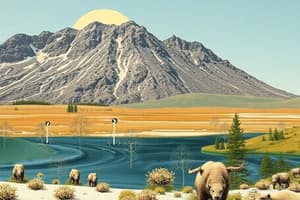Podcast
Questions and Answers
What is found in the tundra biome?
What is found in the tundra biome?
- Deserts
- Grasslands
- Tropical Rain Forests
- North America and Russia (correct)
What types of vegetation are found in the tundra?
What types of vegetation are found in the tundra?
Shrubs, sedges, mosses, lichens, and grasses.
How many species of land mammals are found in the tundra?
How many species of land mammals are found in the tundra?
- 100
- 48 (correct)
- 75
- 20
Plants in the tundra grow high above the ground to conserve heat.
Plants in the tundra grow high above the ground to conserve heat.
What adaptations do animals in the tundra have?
What adaptations do animals in the tundra have?
What is the annual precipitation in the tundra?
What is the annual precipitation in the tundra?
What is the temperature range in the tundra?
What is the temperature range in the tundra?
What process contributes to soil fertility in the tundra?
What process contributes to soil fertility in the tundra?
Humans commonly live in the tundra.
Humans commonly live in the tundra.
What impact does global warming have on the tundra?
What impact does global warming have on the tundra?
Where is the taiga biome located?
Where is the taiga biome located?
What type of trees are prevalent in the taiga?
What type of trees are prevalent in the taiga?
How do plants in the taiga adapt to winter?
How do plants in the taiga adapt to winter?
What is the precipitation range in the taiga?
What is the precipitation range in the taiga?
What is the temperature range in the taiga?
What is the temperature range in the taiga?
Soil in the taiga is highly fertile.
Soil in the taiga is highly fertile.
What human impacts affect the taiga biome?
What human impacts affect the taiga biome?
What types of animals are found in the grasslands?
What types of animals are found in the grasslands?
What is the climate like in grasslands?
What is the climate like in grasslands?
Grass in grasslands can regrow after being eaten down to the ground.
Grass in grasslands can regrow after being eaten down to the ground.
What is a significant negative human impact on grasslands?
What is a significant negative human impact on grasslands?
Deciduous forests are found predominantly in Europe.
Deciduous forests are found predominantly in Europe.
What is the average annual precipitation in deciduous forests?
What is the average annual precipitation in deciduous forests?
What part do trees play in the deciduous forest ecosystem?
What part do trees play in the deciduous forest ecosystem?
What adaptation allows animals in deciduous forests to survive winter?
What adaptation allows animals in deciduous forests to survive winter?
What is a human impact on deciduous forests?
What is a human impact on deciduous forests?
What vegetation is typical in chaparral biomes?
What vegetation is typical in chaparral biomes?
What climate conditions characterize deserts?
What climate conditions characterize deserts?
Animals in deserts are typically large and active during the day.
Animals in deserts are typically large and active during the day.
What types of plants are found in deserts?
What types of plants are found in deserts?
Where are savannas located?
Where are savannas located?
What is a key characteristic of plant roots in savannas?
What is a key characteristic of plant roots in savannas?
What is the average rainfall in savannas?
What is the average rainfall in savannas?
How do soil conditions affect savannah vegetation?
How do soil conditions affect savannah vegetation?
Where are rainforests primarily located?
Where are rainforests primarily located?
What is a unique feature of rainforest plants?
What is a unique feature of rainforest plants?
Rainforests contain nutrient-poor soil.
Rainforests contain nutrient-poor soil.
What human activity threatens rainforests?
What human activity threatens rainforests?
What are alpine regions also known as?
What are alpine regions also known as?
What adaptations do alpine plants have?
What adaptations do alpine plants have?
Alpine climates have high amounts of precipitation year-round.
Alpine climates have high amounts of precipitation year-round.
What is a significant impact of human activity on alpine environments?
What is a significant impact of human activity on alpine environments?
Flashcards are hidden until you start studying
Study Notes
Tundra
- Found in North America and Russia, characterized by harsh climates.
- Dominated by low vegetation such as shrubs, sedges, mosses, lichens, and grasses.
- Supports around 48 species of land mammals including foxes, bears, rodents, wolves, and deer.
- Plants grow close to the ground to conserve heat, flourishing during a brief summer.
- Animals adapt with thick fur or feathers, some living underground or migrating in summer.
- Receives about 6-10 inches of annual precipitation, with temperatures ranging from 3-16°C (37-60°F).
- Soil is very shallow due to permafrost and fertility depends primarily on animal droppings.
- Acts as a carbon sink; however, global warming causes carbon release and mining contributes to pollution.
- Human habitation is virtually absent due to extreme conditions.
Taiga
- Located just below the tundra, spanning across Eurasia and North America.
- High migratory presence of insects and birds; mammals include rabbits, squirrels, bobcats, and lynxes.
- Characterized by coniferous trees, along with some mosses and lichens.
- Plant adaptations include waxy, needle-like leaves to prevent freezing, and the retention of leaves for continuous photosynthesis.
- Supports diverse predator-prey relationships; some birds remain year-round if food sources are available.
- Receives 30-85 cm of precipitation annually, with temperatures ranging from -54 to 21°C (-65 to 70°F).
- Soil is generally poor in nutrients because of low decomposition rates due to cold temperatures.
- Human populations are sparse, and issues such as logging and hydro power usage cause habitat destruction.
Grasslands
- Found north and south of the tropics, particularly in the central United States.
- Dominated by species such as Sunflower and Buffalo Grass.
- Wildlife includes wild turkeys, eagles, and coyotes.
- Grass is resilient, allowing herbivores to graze without leading to extinction; bison are adapted to the primary vegetation.
- Receives varying rainfall: 10-30 inches in temperate areas and 25-60 inches in tropical areas.
- Temperature ranges from -40 to 21°C (-40 to 70°F).
- Soil is exceptionally nutrient-rich due to the decay of plant roots, making it ideal for agriculture.
- Significant human farming activity, emphasizing the importance of practices such as crop rotation to mitigate nutrient depletion.
Deciduous Forest
- Predominantly found in Eastern North America and Central Europe.
- Rich in tree diversity, with a variety of species contributing to the ecosystem.
- Habitat supports species like spiders, salamanders, and cardinals.
- Plants adapt by growing towards sunlight and soaking up nutrients from the soil.
- Wildlife hibernates in winter, utilizing local resources when active.
- Receives 30-60 inches of rainfall annually, and temperatures average around 10°C (50°F).
- Soil fertility is enhanced by decomposed leaves, supporting rich agricultural activities.
- Urban development and deforestation threaten habitats; promoting tree planting can aid conservation.
Chaparral
- Located on the west coast of the U.S., South America, and around the Mediterranean.
- Plant species include broom, shrubs, and poison oak.
- Wildlife comprises small animals like ladybugs, jackrabbits, and acorn woodpeckers.
- Plants possess small, hard leaves for moisture retention and drought resistance.
- Many animals are small and nocturnal adaptations for survival in dry conditions.
- Receives 10-17 inches of rain annually and experiences temperatures ranging from 10-40°C (50-104°F).
- Soil is rocky and prone to erosion, making conservation efforts vital.
- Human impacts include deforestation for development and increased fire risk; proactive measures are needed to support habitats.
Desert
- Typically located along the tropics characterized by very low humidity.
- Vegetation consists of short trees and shrubs adapted to arid conditions.
- Wildlife features species like insects, reptiles, and kangaroo rats.
- Plants are designed to store water and cope with extreme temperatures, holding essential nutrients.
- Animals are generally small and nocturnal to avoid daytime heat.
- Average precipitation is about 15-26 cm annually, with temperatures ranging between 20-25°C (68-77°F) for hot deserts, and -2 to 4°C (28-39°F) for cold deserts.
- Soil is often grainy, providing low water retention.
- Human activities lead to environmental challenges like land disturbance and pollution; practices like regulating vehicles can help mitigate damages.
Savanna
- Located near the equator, surrounding tropical rainforests.
- Rich in grasses and scattered acacia trees.
- Major wildlife includes elephants and various birds, such as buzzards.
- Plant adaptations include long roots and thick bark to resist fire.
- Animals are equipped for migration and possess adaptations to conserve water.
- Receives 15-25 inches of rain annually, with an average temperature of 21°C (70°F).
- Soil is porous and thin, limiting nutrient availability.
- Savannas are utilized for grazing livestock; care is needed to maintain ecological balance and avoid degradation.
Rainforest
- Found in regions like the Amazon Basin, Congo Basin, and Southeast Asia.
- Home to a diverse range of species including monkeys, butterflies, and mosquitoes.
- Plant diversity includes orchids, water lilies, and climbing vines.
- Special features like "drip tips" on leaves help manage heavy rainfall.
- Many animals utilize trees for shelter; bird species are often specially adapted for feeding on fruit.
- Experiences over 100 inches of rainfall a year and maintains temperatures between 20-34°C (68-93°F).
- Soil is nutrient-rich due to organic materials from decomposed fauna.
- Deforestation and urban development pose considerable threats; conservation strategies include replanting efforts and promoting sustainable land use.
Alpine
- Also referred to as boreal/coniferous, found in mountain regions.
- Animal inhabitants include cougars, snowshoe hares, gophers, and bighorn sheep.
- Plant life features species like bear grass and wild potatoes adapted to harsh conditions.
- Vegetation mostly grows close to the ground to withstand harsh winds and snow.
- Wildlife adaptations include migration or hibernation, with many species possessing body structures for heat retention.
- Annual precipitation is around 30 cm, with terrain presenting poor soil conditions.
- Human impacts from mining and agriculture necessitate careful resource management and ecological considerations.
Studying That Suits You
Use AI to generate personalized quizzes and flashcards to suit your learning preferences.




